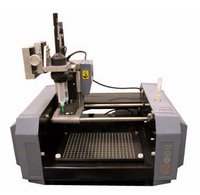 Two dimensions just aren't enough for developers of printers: soon, human organs or fabricated products might come out of your desktop printer. OK, maybe that's a stretch—at least, right now—but scientists are developing printers that can use bio-ink and bio-paper to print out three-dimensional biological materials. So far, researchers at three American universities have collaborated to create technology that can print tubes akin to blood vessels and sheets of heart muscle cells. Glenn Prestwich of the University of Utah's team says that he thinks they'll be able to print kidneys and livers eventually.
Two dimensions just aren't enough for developers of printers: soon, human organs or fabricated products might come out of your desktop printer. OK, maybe that's a stretch—at least, right now—but scientists are developing printers that can use bio-ink and bio-paper to print out three-dimensional biological materials. So far, researchers at three American universities have collaborated to create technology that can print tubes akin to blood vessels and sheets of heart muscle cells. Glenn Prestwich of the University of Utah's team says that he thinks they'll be able to print kidneys and livers eventually. In the product realm, Future Feeder links to a Salon article by Boingboing's David Pescowitz, on "desktop manufacturing." He writes that designers have used 3D printing for a decade to create prototypes of products, but new technology is being developed to make such devices functional:
Researchers at many corporate and university laboratories are brewing inks of semiconducting nanocrystals and using cannibalized inkjet printers to pattern the nanomaterials into circuits on plastic, paper and even cloth. Printable electronics is likely to hit the mainstream first in flexible displays that can be cranked out in rolls and then as UPC bar-code-killing RFID (radio frequency identification) tags stamped right on a product package.--snip--
The next step is to print mechanical structures -- motors and actuators, devices for controlling or moving something. At MIT, Joseph Jacobson and his students have printed microscopic linear drive motors, similar to pistons, and thermal actuators that are triggered by heat. These kinds of pinhead-size devices, called MEMS (micro-electromechanical systems), are found in everything from automobile air bags to dishwashers. To make larger mechanisms, such as the components that cause a blender's blades to spin when it's switched on, Canny and his Berkeley colleagues propose filling inkjet cartridges with electroactive polymers, essentially plastic that contracts when zapped with electricity. The same material generates a voltage when flexed, making it an ideal choice for buttons or switches in a printed object.
No comments:
Post a Comment